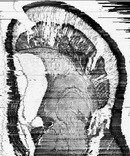Diploma Thesis
"Neuroanatomy and ultrastructure of specialized visual pathways in the stomatopod crustaceen Gonodactylus chiragra"
Licht- und elektronenmikroskopische Untersuchungen am zentralen Sehsysystem von Stomatopoden
Gonodactyloid stromatopods inhabit the shollows of tropical and subtropical seas, which are spectrally rich and attenuation of incident light is minimal. These animals are diurnal predators which exhibit complex hunting and social behaviours.
Specialized regions in each compound eye, termed the midband, which comprises six parallel rows of ommatidia, are thought to serve the tasks of true color and polarisation vision and to form the neural basis of these behaviors.
With a rich background of knowledge on the topic of polarisation vision in stomatopod species, we try to provide detailed insights in the ultrastructure of the neuroanatomical arrangement of the polarisation sensitive neural pathways and their interconnectivity at certain loci.
To achieve this goal we are going to apply several methods:
- computer-aided 3D-reconstruction of the optic lobes and their accessory lobes
- electron microscopy (TEM, Auriga)
- laser scanning microscopy (CLSM)
Gallery
Image 1: Gonodactylus chiragra: Midband ommatidia
Image 2: Gonodactylus chiragra: longitudinal section through the eye stack
Image 3: Gonodactylus chiragra: frontal section through the medulla externa (for orientation see piture to the left)




